Traveling is more than seeing places; it is about experiencing them. Backpackers, solo travelers, and budget tourists often seek destinations that offer adventure without draining their pockets. Uganda, the "Pearl of Africa," can be a place where every dollar spent on a road trip rewards you with memories of a lifetime.
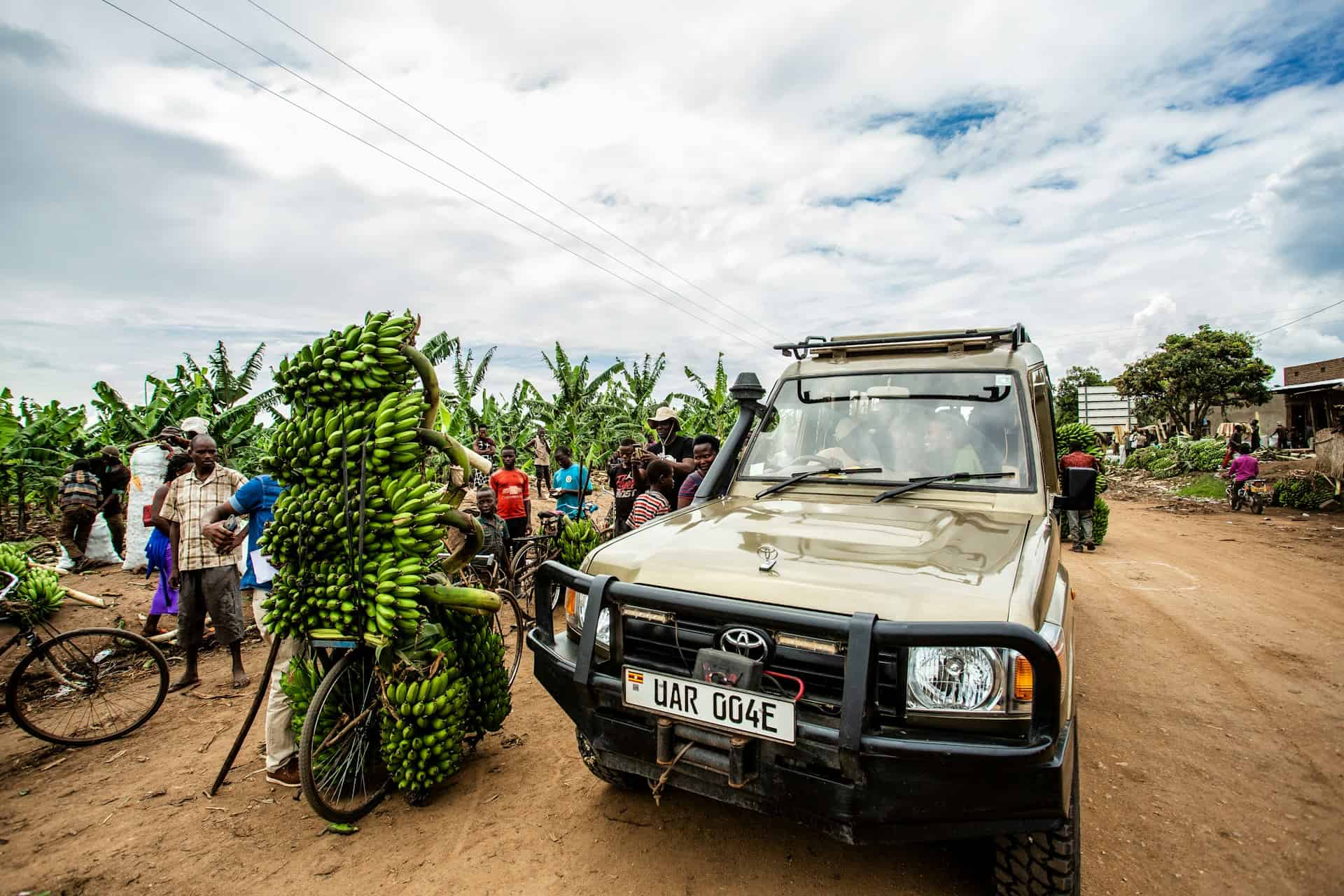
A Toyota SUV drives past a bicycle loaded with bananas (photo: Mwanje Henry)
Uganda is neither an expensive nor a cheap destination; it all depends on where you choose to go and what you decide to do. That's where this guide comes in handy.
But how can a backpacker plan a successful safari in Uganda? Let's take the journey step by step, from the very first thought of traveling to the actual safari experience and finally to the joy of returning home with unforgettable memories.
A backpacker is not just any traveler. They are individuals who travel light, prefer affordable means of transportation, opt for budget-friendly accommodations, and seek genuine experiences.
Backpackers often travel independently, carrying only what is necessary, and their focus is on connecting with people, nature, and culture rather than chasing luxury.
For these reasons, Uganda is an ideal destination for backpackers. The country welcomes visitors with open arms, and its diverse food, culture, and wildlife make it the perfect place for adventurous, budget-conscious travelers.
Every trip starts with a thought, such as "I want to travel to Uganda." For a backpacker or budget lone traveler, the first step after this dream is saving.
The best way is to set aside money consistently. This prevents last-minute struggles and ensures there is enough for the essentials, such as flights, park permits, car rental, and meals.
At this stage, a traveler should begin reading from trusted Uganda travel sources, such as TripAdvisor and travel guidebooks, where practical information on safaris, self-driving adventures, and local experiences can be found. Reliable information saves you from miscalculations and wrong bookings.
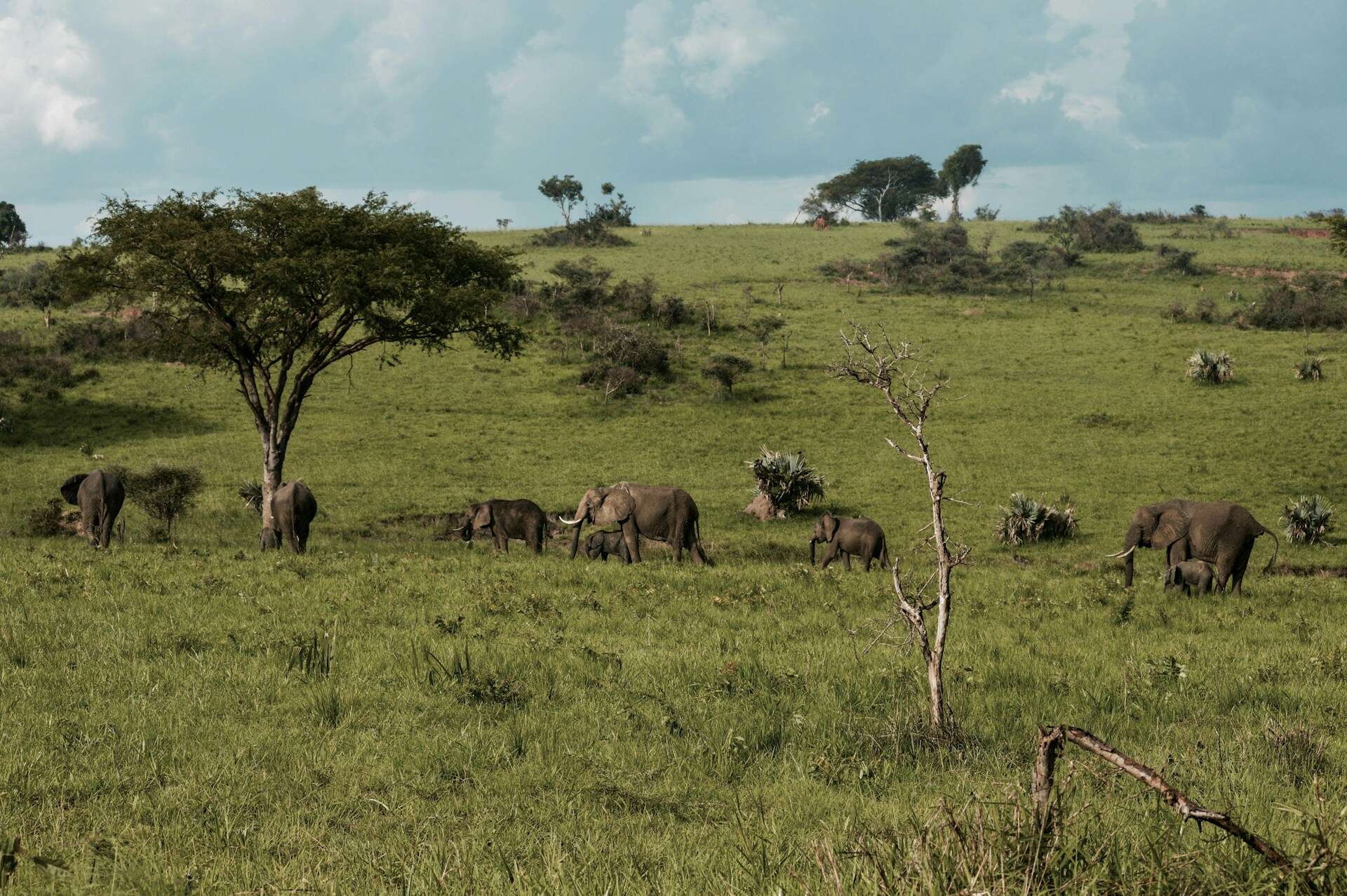
A herd of elephants in Murchison Falls National Park (photo: Matthew Essman)
Planning is the backbone of every successful safari. For anyone considering a backpacking trip to Uganda, proper preparation makes all the difference. One of the first things to think about is flights.
Air tickets are usually cheaper when booked at least three to six months in advance of travel. If you are flexible with dates, traveling during the off-peak seasons - March to May and September to November - often guarantees the best deals and can help you save significantly.
Another key element is car rental. Backpackers benefit most from renting cars to self drive Uganda privately. A self-guided experience offers travelers both flexibility and independence. Instead of spending heavily on expensive customized safaris, a traveler can hire a fitted car with a rooftop tent for a never-ending drive to roads anywhere in Africa.
This option serves a dual purpose, acting as both transport and accommodation, making it one of the most reliable holiday choices for an adventurous budget traveler.
Equally important is drafting a simple itinerary. Uganda offers a wealth of attractions, including gorilla trekking, game drives, mountain hiking, community visits, boat rides, bird-watching, and nature walks.
With so many activities available, having a clear plan ensures that you make the most of your journey without missing out on unforgettable experiences.
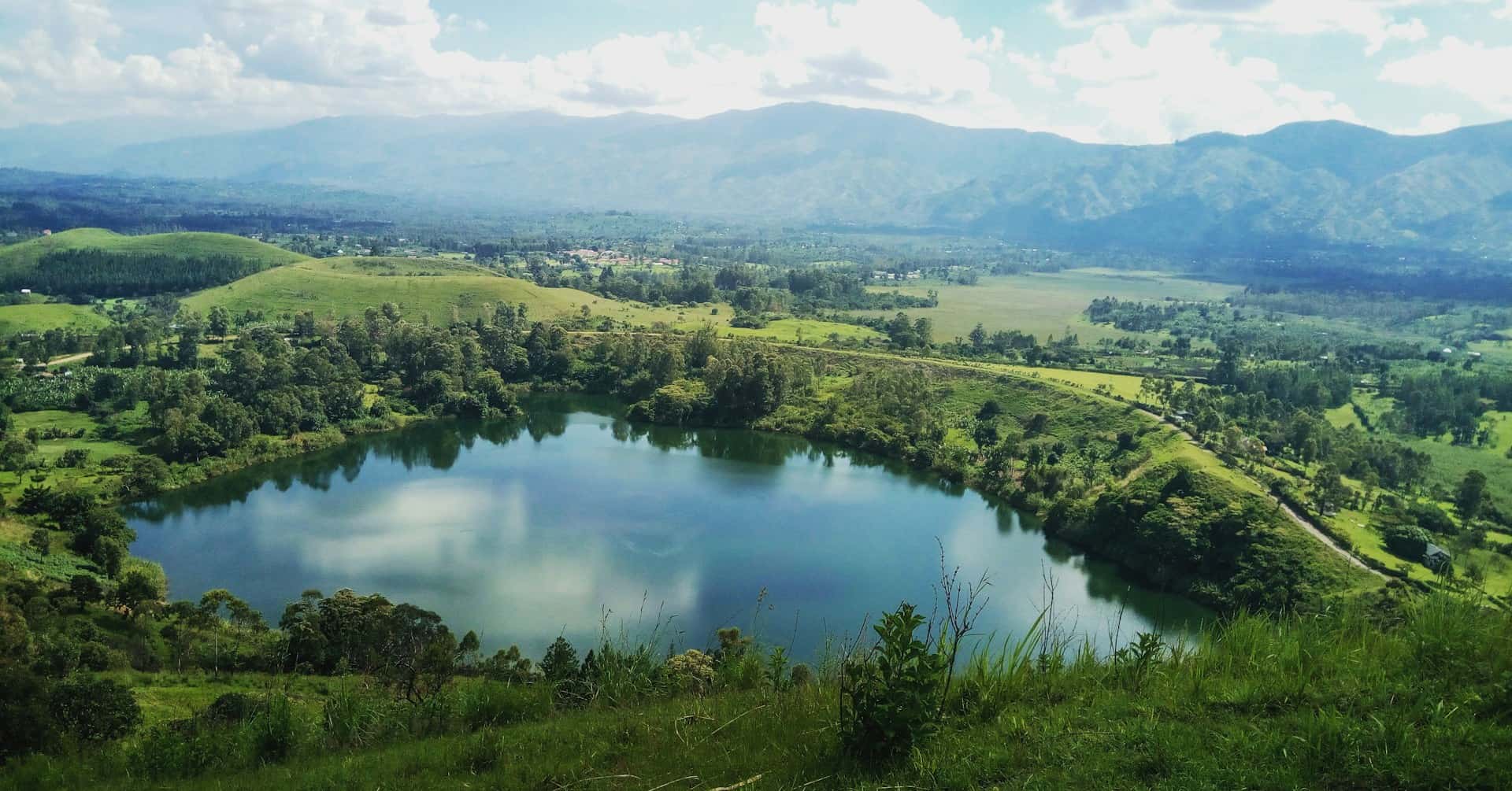
A crater lake (photo: Keith Kasaija)
The main entry for Uganda is Entebbe International Airport, located near Lake Victoria. After landing, immigration and customs are simple, and the warm Ugandan air will welcome you.
Flights are often cheaper at night or on mid-week days. Once you arrive, the real adventure begins - renting your car and preparing for the road trip.
Backpackers in Uganda often find self-drive rentals to be the perfect way to explore the country. The benefits are many, starting with the freedom to decide when to start the engine and when to stop without being tied to fixed schedules.
This freedom also comes with flexibility, allowing travelers to change routes at any time and discover hidden gems that are often missed on guided tours.
Renting a car in Uganda is also cost-friendly, especially when equipped with a rooftop tent, since it helps save on accommodation expenses.
On top of that, the experience is just as adventurous as any other safari option, but without the heavy price tag, giving backpackers a chance to enjoy Uganda fully while keeping within budget.
Self Driving Uganda provides a fleet of vehicles to choose from. For a backpacker, the best options are usually a 4x4 Safari Jeep with a rooftop tent, a Toyota Prado TX, a Land Cruiser VX, a V8, and a GX, as well as a Toyota Rav4. These vehicles are reliable and sturdy, making them ideal for handling Uganda's rough and challenging roads.
The rooftop tent adds extra convenience, as it allows you to camp almost anywhere that is safe - whether near a national park, by the shores of a lake, or at a community campsite.
This combination of durability and comfort makes it the most practical choice for backpackers seeking to strike a balance between adventure and affordability.
Before you begin your journey, it is essential to carefully review the rental agreement provided by the car rental company. Take your time to understand the terms, especially the details about insurance. Verify whether the car is insured with third-party coverage and if the coverage is guaranteed.
After going through the paperwork, proceed with the car inspection. Examine the vehicle closely and, if you notice any exterior damage, report it to the rental company before starting the engine.
Another key requirement is your local driving license. It is a must-have document because no company will allow you to rent a car without it. An international driving license is not a must-have while driving in Uganda.
Ultimately, you may choose a more hassle-free way to make your safari. Instead of worrying about driving yourself, you can choose to have a driver handle everything for you.
This way, you relax and fully enjoy the trip that you have saved for quite some time to make possible. Let the company take care of the details while you sit back, enjoy, and experience your adventure like a big boss.
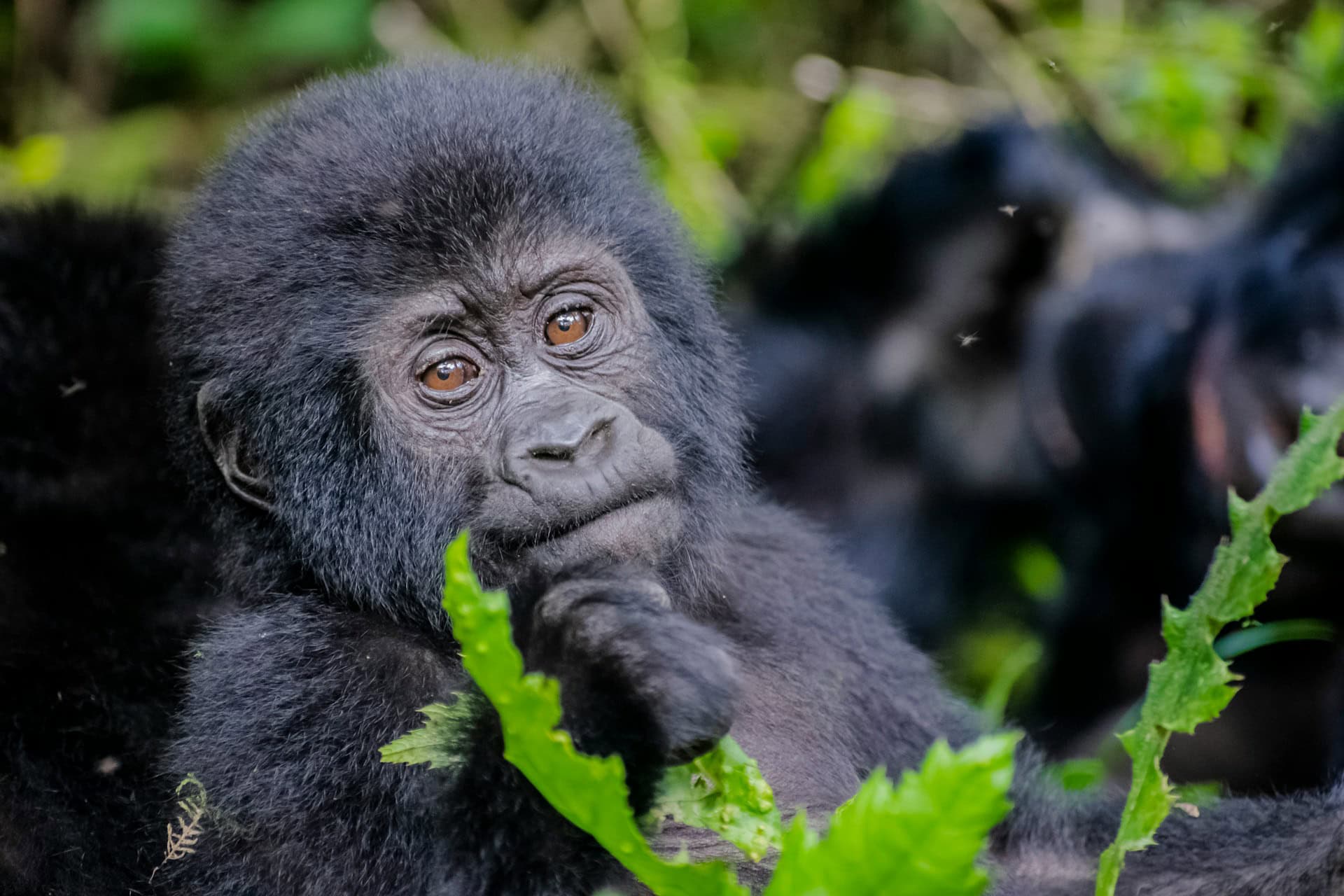
Baby mountain gorilla in Bwindi Impenetrable National Park (photo: Dixon Newman)
Gorilla trekking is one of the primary reasons travelers from around the world choose to visit Uganda. The experience is unlike any other, a chance to see endangered mountain gorillas in their natural surroundings.
This extraordinary adventure takes place in either Bwindi Impenetrable National Park or Mgahinga Gorilla National Park, two of Uganda's most remarkable conservation areas.
Although gorilla trekking is a dream trip for many, if your goal is to explore the entire country, consider forgoing it due to its very high cost. The extra $ 1,000 you would spend on gorilla trekking alone can help you explore many other parts that can enrich your Uganda safari experience.
However, in case you choose to go for the gorilla trekking experience, it is important to note that the process begins long before you set foot in the forest.
The first and most important step is booking a gorilla permit. Only a limited number of permits are issued each day; it is always advisable to secure one well in advance to guarantee your spot.
On the trekking day, everything starts early. You are required to report to the park headquarters by 7 am. Here, the rangers give you a detailed briefing about the gorilla trek, explain the rules to follow, and assign you to a specific gorilla family group. This moment sets the tone for the adventure ahead.
The actual trek is both challenging and exciting. Depending on where the gorillas are hanging out, the hike can last anywhere between two and seven hours. You navigate through dense vegetation, climb slippery slopes, and follow narrow trails as your guides use their skills to track the gorillas.
Every step brings anticipation, and the forest itself is alive with numerous bird species, monkeys, and the sounds of nature, making the journey just as memorable as the destination.
The encounter itself is the most powerful part of the experience. Once you finally come across the gorilla family, you are allowed to spend a whole hour in their presence.
Watching silverbacks' strength, mothers tenderly caring for their infants, and young gorillas playing around fills you with awe. It is a profoundly emotional moment that words often fail to fully capture - a connection between humans and nature that stays with you forever.
After the trek, you make your way back to the starting point, tired but deeply fulfilled. The memories of the gorillas remain etched in your heart long after you leave the forest.
For a backpacker, every coin spent on gorilla trekking is worth it. It is a once-in-a-lifetime opportunity to sit just a few meters away from one of the world's most endangered primates, an experience that goes beyond adventure and touches the soul.
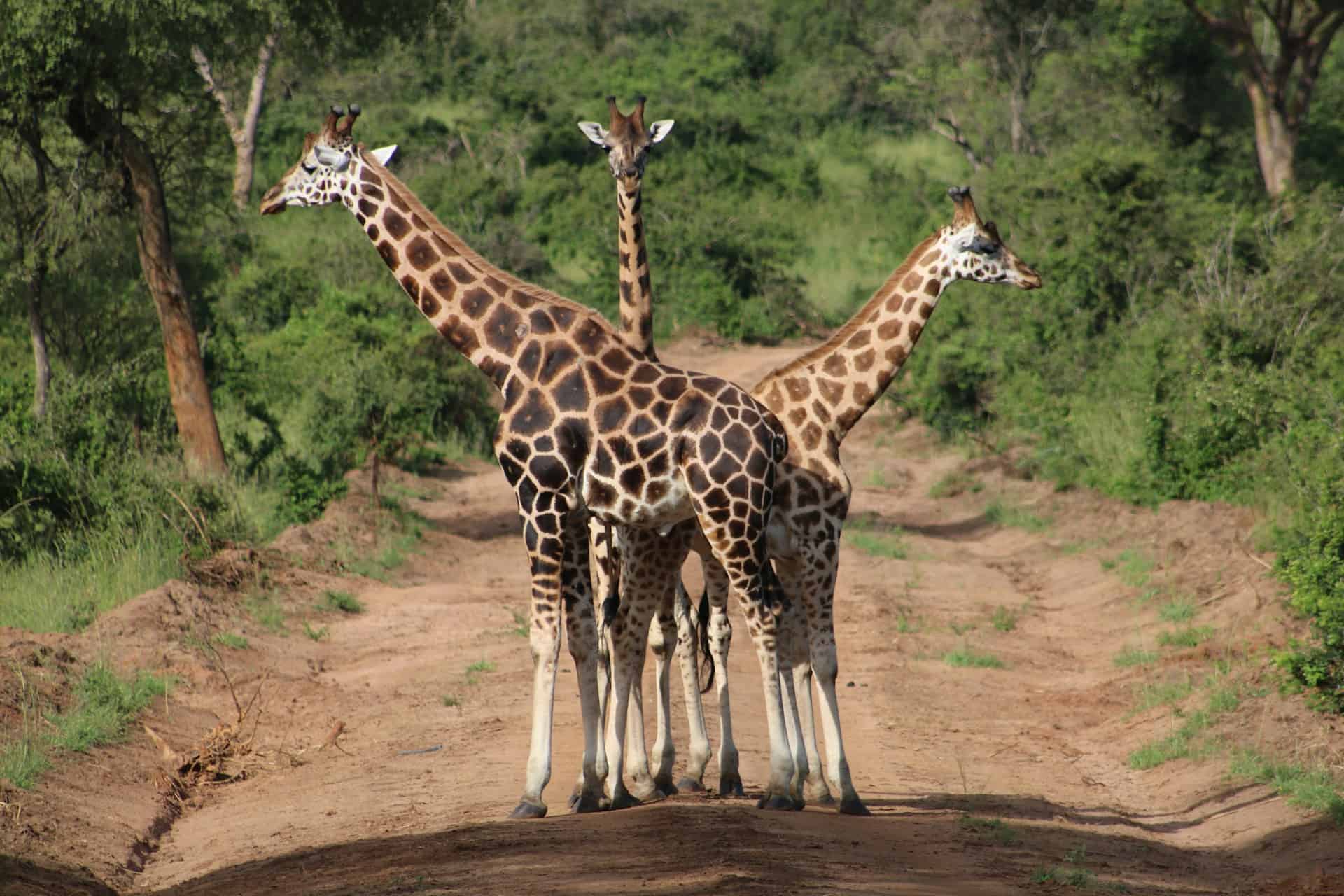
Giraffes (photo: Lisette Verwoerd)
Game drives are one of the most exciting ways to explore Uganda's wildlife. While many travelers visit the country for gorilla trekking, Uganda also offers classic African safaris where you can see the famous Big Five and many other animals in their natural habitat.
A game drive is more than just watching animals; it is about feeling the cool morning air, enjoying the sunrise, and experiencing the rhythm of the wild.
Most game drives start very early, around 6:30 am, when animals are most active. Before heading out, many travelers have a list in mind of what they hope to see: lions, elephants, buffalo, giraffes, leopards, antelopes, and the hundreds of beautiful birds that fill the skies.
With your rented car, you slowly drive across the open plains, sometimes with the help of a park ranger who can guide you and point out hidden wildlife.
The best thing about a game drive is that it is unpredictable. Unlike a zoo, where animals are caged, here nature decides what you will see. On one morning, you might watch lions hunting, while on another, you may find elephants splashing in a river. Every game drive is different, and no two experiences are ever the same.
Uganda has some of the best parks for game drives, including:
For backpackers and adventure seekers, a game drive is not just an activity-it is often the highlight of a safari in Uganda. The wild landscapes and close encounters with animals create memories that will last a lifetime.
Ugandan food is affordable and delicious, making it a good choice for backpackers who want to enjoy fantastic meals without breaking the bank.
One of the most common street foods is the rolex. It is made of fried eggs rolled inside a chapati, and you can buy it for as little as $1. Another very affordable meal is chapati with beans, which costs about 80 cents.
For breakfast, many Ugandans eat katogo, a filling dish made with matoke (bananas) cooked together with beef, beans, or other foods. If you want to try something more traditional, then luwombo is a good choice. It is food simmered in banana leaves, which lends it a unique flavor.
Apart from these, you can also enjoy local staples like cassava, sweet potatoes, and yams. Eating Ugandan food is not only cheap, but it also supports local people and offers a genuine taste of the country.
Backpackers in Uganda often find that the most memorable part of their journey is the time spent with local communities. For example, visiting the villages around Mbale and Mount Elgon offers a chance to see daily rural life and meet the Bagisu people, known for their traditional dances and ceremonies.
Here, you can buy handwoven baskets, colorful mats, and carved wooden ornaments directly from local artisans. If you are lucky, you might witness or even join in the famous Imbalu circumcision ceremony, a centuries-old rite of passage, where dances, drumming, and singing fill the air.
In southwestern Uganda, near Kisoro and Kabale, the Batwa communities offer a different experience. You can explore their forest settlements, learn about their traditional way of life, and even participate in storytelling sessions where elders recount myths and legends of the forest.
The Batwa also perform unique dances and songs that celebrate nature, giving backpackers a glimpse into a culture deeply connected to the land.
Traveling to central Uganda around Kampala and Mukono, you can visit the villages of the Baganda people. Here, markets are lively, and you can buy drums, wooden carvings, and hand-embroidered fabrics.
Cultural centers often host dance and music performances, where visitors can try the traditional Kiganda dances, clapping and moving to the rhythmic drumbeats, experiencing the joy and energy of the local community firsthand.
In northern Uganda, around Gulu and Lira, the Acholi people welcome visitors into their villages with warm smiles and open hearts. You can learn about traditional ceremonies, such as the dance of the spear, listen to folk music, and observe how everyday tasks like cooking, farming, and weaving are done in a communal setting.
Backpackers are often invited to join in the dances, clapping and stepping in time with the performers, making the experience truly immersive.
Across Uganda, each village and tribe has its own way of celebrating life through music, dance, crafts, and ceremonies. With over 50 tribes, every stop offers something new to see and do.
The friendliness of the people, combined with the richness of their traditions, makes cultural interactions in Uganda an unforgettable part of any backpacking adventure.
For backpackers looking to explore Uganda on a budget, rooftop tents are a great choice. These tents are mounted on top of a rental car and are very easy to set up and take down. They provide a comfortable sleeping space without requiring a hotel or lodge.
With a rooftop tent, you can camp in safe, designated campsites near national parks or in community-run, budget-friendly sites. This approach lets you stay close to nature while keeping costs low.
Imagine waking up to the African sunrise, hearing birds sing, or at night, listening to the sounds of crickets or the distant roar of lions - it's an authentic safari experience.
The best vehicles for rooftop tents are sturdy 4x4s, such as the Toyota Land Cruiser or Prado. They can handle rough roads, carry the tent safely, and give you enough space for luggage and camping gear.
When camping, having the right gear makes a big difference. Essentials include sleeping bags, pillows, portable stoves, cooking utensils, lanterns or headlamps, and folding chairs. You can also bring a cooler for food and drinks, as well as a small first aid kit for added safety.
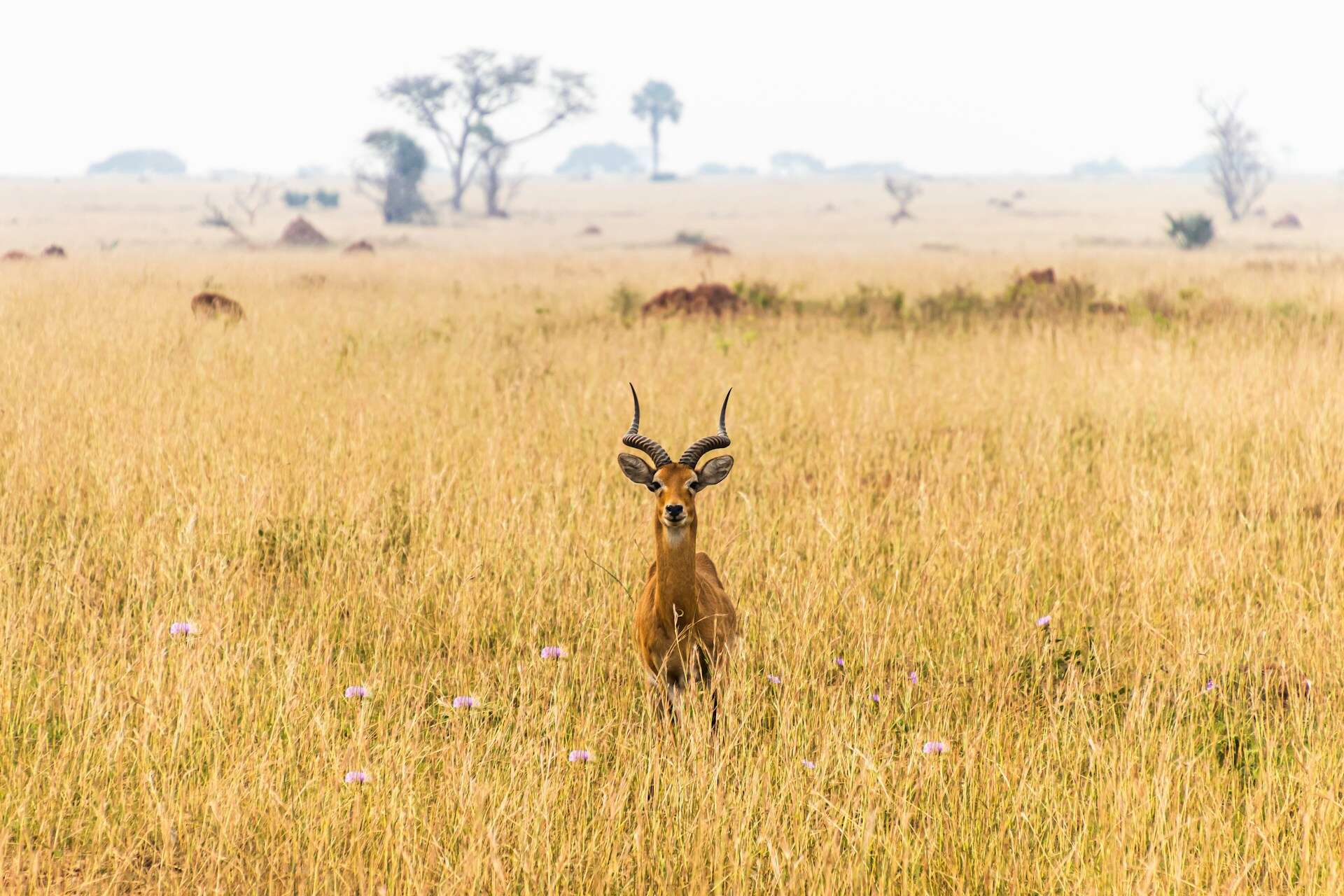
A Ugandan kob (photo: Andrew S)
When planning a trip, safety and preparation should be your top priorities. Avoid traveling at night, as it can be riskier due to poor visibility and unpredictable road conditions.
Always plan ahead and avoid last-minute bookings to ensure smoother travel arrangements. Ensure that you respect all contracts and agreements with car rental companies, as this helps prevent disputes and ensures a hassle-free experience.
Travel light, but don't forget to carry the essential items you might need along the way. It is also important to inform a next of kin or someone back home about your travel plans, so someone is aware of your whereabouts.
Carry local currency, especially when visiting rural areas, as it can be challenging to access ATMs or make card payments.
Lastly, obtain travel insurance before leaving your country for protection against unexpected events or emergencies that may arise during your trip.
Thus, a successful self-drive safari for a backpacker in Uganda is not about luxury. It is about freedom, affordable exploration, and connecting deeply with people and nature. From the first moment of saving at home, to flying into Entebbe, to driving through national parks and meeting gorillas face-to-face, Uganda delivers beyond expectation.
In conclusion, if you are a solo traveler or backpacker seeking an authentic African road trip, Uganda is one of the least congested safari destinations, as well as a safe option for both solo and budget travelers.
_____
This story is brought to you in partnership with Self Driving Uganda Ltd.
The post Uganda Road Trip: A Guide for Backpackers and Solo Travelers appeared first on Go Backpacking.

A Toyota SUV drives past a bicycle loaded with bananas (photo: Mwanje Henry)
Uganda is neither an expensive nor a cheap destination; it all depends on where you choose to go and what you decide to do. That's where this guide comes in handy.
But how can a backpacker plan a successful safari in Uganda? Let's take the journey step by step, from the very first thought of traveling to the actual safari experience and finally to the joy of returning home with unforgettable memories.
Getting Started
A backpacker is not just any traveler. They are individuals who travel light, prefer affordable means of transportation, opt for budget-friendly accommodations, and seek genuine experiences.
Backpackers often travel independently, carrying only what is necessary, and their focus is on connecting with people, nature, and culture rather than chasing luxury.
For these reasons, Uganda is an ideal destination for backpackers. The country welcomes visitors with open arms, and its diverse food, culture, and wildlife make it the perfect place for adventurous, budget-conscious travelers.
Step 1: The Dream and First Savings
Every trip starts with a thought, such as "I want to travel to Uganda." For a backpacker or budget lone traveler, the first step after this dream is saving.
The best way is to set aside money consistently. This prevents last-minute struggles and ensures there is enough for the essentials, such as flights, park permits, car rental, and meals.
At this stage, a traveler should begin reading from trusted Uganda travel sources, such as TripAdvisor and travel guidebooks, where practical information on safaris, self-driving adventures, and local experiences can be found. Reliable information saves you from miscalculations and wrong bookings.
Planning the Safari

A herd of elephants in Murchison Falls National Park (photo: Matthew Essman)
Planning is the backbone of every successful safari. For anyone considering a backpacking trip to Uganda, proper preparation makes all the difference. One of the first things to think about is flights.
Air tickets are usually cheaper when booked at least three to six months in advance of travel. If you are flexible with dates, traveling during the off-peak seasons - March to May and September to November - often guarantees the best deals and can help you save significantly.
Another key element is car rental. Backpackers benefit most from renting cars to self drive Uganda privately. A self-guided experience offers travelers both flexibility and independence. Instead of spending heavily on expensive customized safaris, a traveler can hire a fitted car with a rooftop tent for a never-ending drive to roads anywhere in Africa.
This option serves a dual purpose, acting as both transport and accommodation, making it one of the most reliable holiday choices for an adventurous budget traveler.
Equally important is drafting a simple itinerary. Uganda offers a wealth of attractions, including gorilla trekking, game drives, mountain hiking, community visits, boat rides, bird-watching, and nature walks.
With so many activities available, having a clear plan ensures that you make the most of your journey without missing out on unforgettable experiences.
Packing Tips
- Comfortable hiking boots.
- Insurance coverage (a must for solo travelers).
- A GPS device or smartphone with offline maps.
- A satellite phone (for staying in touch in remote areas).
- Cash (since rural areas often don't accept cards).
- A camera.
- Light clothing for daytime, warm clothing for cool evenings.
- A list of emergency contacts and a next of kin at home.
- Travel light, but carry essentials that ensure safety and comfort.
Arriving in Uganda

A crater lake (photo: Keith Kasaija)
The main entry for Uganda is Entebbe International Airport, located near Lake Victoria. After landing, immigration and customs are simple, and the warm Ugandan air will welcome you.
Flights are often cheaper at night or on mid-week days. Once you arrive, the real adventure begins - renting your car and preparing for the road trip.
Renting a Car for a Self-Drive
Backpackers in Uganda often find self-drive rentals to be the perfect way to explore the country. The benefits are many, starting with the freedom to decide when to start the engine and when to stop without being tied to fixed schedules.
This freedom also comes with flexibility, allowing travelers to change routes at any time and discover hidden gems that are often missed on guided tours.
Renting a car in Uganda is also cost-friendly, especially when equipped with a rooftop tent, since it helps save on accommodation expenses.
On top of that, the experience is just as adventurous as any other safari option, but without the heavy price tag, giving backpackers a chance to enjoy Uganda fully while keeping within budget.
Self Driving Uganda provides a fleet of vehicles to choose from. For a backpacker, the best options are usually a 4x4 Safari Jeep with a rooftop tent, a Toyota Prado TX, a Land Cruiser VX, a V8, and a GX, as well as a Toyota Rav4. These vehicles are reliable and sturdy, making them ideal for handling Uganda's rough and challenging roads.
The rooftop tent adds extra convenience, as it allows you to camp almost anywhere that is safe - whether near a national park, by the shores of a lake, or at a community campsite.
This combination of durability and comfort makes it the most practical choice for backpackers seeking to strike a balance between adventure and affordability.
Before you begin your journey, it is essential to carefully review the rental agreement provided by the car rental company. Take your time to understand the terms, especially the details about insurance. Verify whether the car is insured with third-party coverage and if the coverage is guaranteed.
After going through the paperwork, proceed with the car inspection. Examine the vehicle closely and, if you notice any exterior damage, report it to the rental company before starting the engine.
Another key requirement is your local driving license. It is a must-have document because no company will allow you to rent a car without it. An international driving license is not a must-have while driving in Uganda.
Ultimately, you may choose a more hassle-free way to make your safari. Instead of worrying about driving yourself, you can choose to have a driver handle everything for you.
This way, you relax and fully enjoy the trip that you have saved for quite some time to make possible. Let the company take care of the details while you sit back, enjoy, and experience your adventure like a big boss.
The Safari Begins - Gorilla Trekking

Baby mountain gorilla in Bwindi Impenetrable National Park (photo: Dixon Newman)
Gorilla trekking is one of the primary reasons travelers from around the world choose to visit Uganda. The experience is unlike any other, a chance to see endangered mountain gorillas in their natural surroundings.
This extraordinary adventure takes place in either Bwindi Impenetrable National Park or Mgahinga Gorilla National Park, two of Uganda's most remarkable conservation areas.
Although gorilla trekking is a dream trip for many, if your goal is to explore the entire country, consider forgoing it due to its very high cost. The extra $ 1,000 you would spend on gorilla trekking alone can help you explore many other parts that can enrich your Uganda safari experience.
However, in case you choose to go for the gorilla trekking experience, it is important to note that the process begins long before you set foot in the forest.
The first and most important step is booking a gorilla permit. Only a limited number of permits are issued each day; it is always advisable to secure one well in advance to guarantee your spot.
On the trekking day, everything starts early. You are required to report to the park headquarters by 7 am. Here, the rangers give you a detailed briefing about the gorilla trek, explain the rules to follow, and assign you to a specific gorilla family group. This moment sets the tone for the adventure ahead.
The actual trek is both challenging and exciting. Depending on where the gorillas are hanging out, the hike can last anywhere between two and seven hours. You navigate through dense vegetation, climb slippery slopes, and follow narrow trails as your guides use their skills to track the gorillas.
Every step brings anticipation, and the forest itself is alive with numerous bird species, monkeys, and the sounds of nature, making the journey just as memorable as the destination.
The encounter itself is the most powerful part of the experience. Once you finally come across the gorilla family, you are allowed to spend a whole hour in their presence.
Watching silverbacks' strength, mothers tenderly caring for their infants, and young gorillas playing around fills you with awe. It is a profoundly emotional moment that words often fail to fully capture - a connection between humans and nature that stays with you forever.
After the trek, you make your way back to the starting point, tired but deeply fulfilled. The memories of the gorillas remain etched in your heart long after you leave the forest.
For a backpacker, every coin spent on gorilla trekking is worth it. It is a once-in-a-lifetime opportunity to sit just a few meters away from one of the world's most endangered primates, an experience that goes beyond adventure and touches the soul.
Game Drives

Giraffes (photo: Lisette Verwoerd)
Game drives are one of the most exciting ways to explore Uganda's wildlife. While many travelers visit the country for gorilla trekking, Uganda also offers classic African safaris where you can see the famous Big Five and many other animals in their natural habitat.
A game drive is more than just watching animals; it is about feeling the cool morning air, enjoying the sunrise, and experiencing the rhythm of the wild.
Most game drives start very early, around 6:30 am, when animals are most active. Before heading out, many travelers have a list in mind of what they hope to see: lions, elephants, buffalo, giraffes, leopards, antelopes, and the hundreds of beautiful birds that fill the skies.
With your rented car, you slowly drive across the open plains, sometimes with the help of a park ranger who can guide you and point out hidden wildlife.
The best thing about a game drive is that it is unpredictable. Unlike a zoo, where animals are caged, here nature decides what you will see. On one morning, you might watch lions hunting, while on another, you may find elephants splashing in a river. Every game drive is different, and no two experiences are ever the same.
Uganda has some of the best parks for game drives, including:
- Queen Elizabeth National Park is famous for its tree-climbing lions and large herds of elephants.
- Murchison Falls National Park is known for its vast savannahs and dramatic Nile River views.
- Kidepo Valley National Park is a remote park with stunning scenery and plenty of wildlife.
For backpackers and adventure seekers, a game drive is not just an activity-it is often the highlight of a safari in Uganda. The wild landscapes and close encounters with animals create memories that will last a lifetime.
Food Experiences
Ugandan food is affordable and delicious, making it a good choice for backpackers who want to enjoy fantastic meals without breaking the bank.
One of the most common street foods is the rolex. It is made of fried eggs rolled inside a chapati, and you can buy it for as little as $1. Another very affordable meal is chapati with beans, which costs about 80 cents.
For breakfast, many Ugandans eat katogo, a filling dish made with matoke (bananas) cooked together with beef, beans, or other foods. If you want to try something more traditional, then luwombo is a good choice. It is food simmered in banana leaves, which lends it a unique flavor.
Apart from these, you can also enjoy local staples like cassava, sweet potatoes, and yams. Eating Ugandan food is not only cheap, but it also supports local people and offers a genuine taste of the country.
Cultural Interactions
Backpackers in Uganda often find that the most memorable part of their journey is the time spent with local communities. For example, visiting the villages around Mbale and Mount Elgon offers a chance to see daily rural life and meet the Bagisu people, known for their traditional dances and ceremonies.
Here, you can buy handwoven baskets, colorful mats, and carved wooden ornaments directly from local artisans. If you are lucky, you might witness or even join in the famous Imbalu circumcision ceremony, a centuries-old rite of passage, where dances, drumming, and singing fill the air.
In southwestern Uganda, near Kisoro and Kabale, the Batwa communities offer a different experience. You can explore their forest settlements, learn about their traditional way of life, and even participate in storytelling sessions where elders recount myths and legends of the forest.
The Batwa also perform unique dances and songs that celebrate nature, giving backpackers a glimpse into a culture deeply connected to the land.
Traveling to central Uganda around Kampala and Mukono, you can visit the villages of the Baganda people. Here, markets are lively, and you can buy drums, wooden carvings, and hand-embroidered fabrics.
Cultural centers often host dance and music performances, where visitors can try the traditional Kiganda dances, clapping and moving to the rhythmic drumbeats, experiencing the joy and energy of the local community firsthand.
In northern Uganda, around Gulu and Lira, the Acholi people welcome visitors into their villages with warm smiles and open hearts. You can learn about traditional ceremonies, such as the dance of the spear, listen to folk music, and observe how everyday tasks like cooking, farming, and weaving are done in a communal setting.
Backpackers are often invited to join in the dances, clapping and stepping in time with the performers, making the experience truly immersive.
Across Uganda, each village and tribe has its own way of celebrating life through music, dance, crafts, and ceremonies. With over 50 tribes, every stop offers something new to see and do.
The friendliness of the people, combined with the richness of their traditions, makes cultural interactions in Uganda an unforgettable part of any backpacking adventure.
Rooftop Tent Camping
For backpackers looking to explore Uganda on a budget, rooftop tents are a great choice. These tents are mounted on top of a rental car and are very easy to set up and take down. They provide a comfortable sleeping space without requiring a hotel or lodge.
With a rooftop tent, you can camp in safe, designated campsites near national parks or in community-run, budget-friendly sites. This approach lets you stay close to nature while keeping costs low.
Imagine waking up to the African sunrise, hearing birds sing, or at night, listening to the sounds of crickets or the distant roar of lions - it's an authentic safari experience.
The best vehicles for rooftop tents are sturdy 4x4s, such as the Toyota Land Cruiser or Prado. They can handle rough roads, carry the tent safely, and give you enough space for luggage and camping gear.
When camping, having the right gear makes a big difference. Essentials include sleeping bags, pillows, portable stoves, cooking utensils, lanterns or headlamps, and folding chairs. You can also bring a cooler for food and drinks, as well as a small first aid kit for added safety.
Safety and Preparation Tips

A Ugandan kob (photo: Andrew S)
When planning a trip, safety and preparation should be your top priorities. Avoid traveling at night, as it can be riskier due to poor visibility and unpredictable road conditions.
Always plan ahead and avoid last-minute bookings to ensure smoother travel arrangements. Ensure that you respect all contracts and agreements with car rental companies, as this helps prevent disputes and ensures a hassle-free experience.
Travel light, but don't forget to carry the essential items you might need along the way. It is also important to inform a next of kin or someone back home about your travel plans, so someone is aware of your whereabouts.
Carry local currency, especially when visiting rural areas, as it can be challenging to access ATMs or make card payments.
Lastly, obtain travel insurance before leaving your country for protection against unexpected events or emergencies that may arise during your trip.
Thus, a successful self-drive safari for a backpacker in Uganda is not about luxury. It is about freedom, affordable exploration, and connecting deeply with people and nature. From the first moment of saving at home, to flying into Entebbe, to driving through national parks and meeting gorillas face-to-face, Uganda delivers beyond expectation.
In conclusion, if you are a solo traveler or backpacker seeking an authentic African road trip, Uganda is one of the least congested safari destinations, as well as a safe option for both solo and budget travelers.
_____
This story is brought to you in partnership with Self Driving Uganda Ltd.
The post Uganda Road Trip: A Guide for Backpackers and Solo Travelers appeared first on Go Backpacking.
